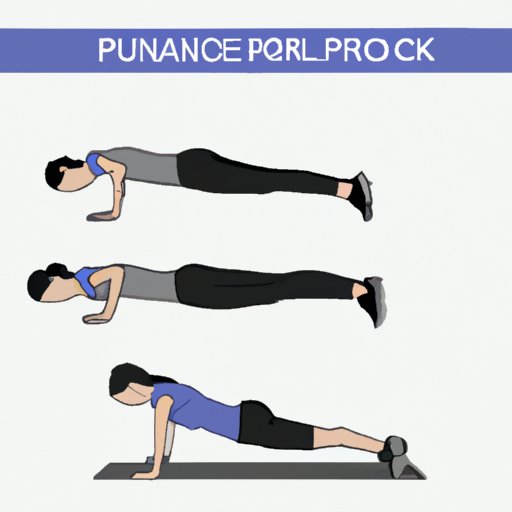Introduction
The plank exercise is a popular core strengthening exercise that engages your abdominal muscles, back muscles, and glutes. It helps to improve your balance and stability while also building strength in your core and upper body. The plank exercise can be done anywhere and requires no equipment, making it an ideal exercise for those who are short on time or want to work out at home.
What are the Benefits of the Plank Exercise?
The plank exercise offers many benefits, including increased core strength, improved posture, injury prevention, and improved balance and stability. This exercise also helps to strengthen your upper body, back, and glutes, as well as your lower body. Additionally, planking helps to increase your metabolism and burn calories, leading to improved overall fitness.
Step-by-Step Guide to Doing the Plank Exercise
Before you begin the plank exercise, make sure you warm up your body with some light stretching and dynamic movements. Once you’re warmed up, follow these steps to do the plank exercise correctly:
How to Get into the Plank Position
To get into the plank position, start by getting into a push-up position and then lower yourself onto your forearms. Your elbows should be directly under your shoulders and your wrists should be directly beneath your elbows. Your feet should be hip-width apart and your toes should be curled under. Make sure your body is in a straight line from your head to your heels.
Proper Form and Body Alignment
It’s important to maintain proper form and body alignment while doing the plank exercise. Keep your core engaged and your neck in line with your spine. Don’t arch your back or let your hips sag. Keep your head in line with your spine and focus on keeping your core tight. You should feel a deep contraction in your abdominals, glutes, and back.
Common Mistakes to Avoid
When doing the plank exercise, it’s important to avoid common mistakes such as arching your back, letting your hips sag, or not engaging your core. Also, make sure to keep your head in line with your spine and don’t look up or down. Finally, don’t hold the plank for too long—it’s better to do shorter planks with proper form than longer planks with poor form.

A Complete Guide to Mastering the Plank Exercise
The plank exercise is a great way to strengthen your core and improve your overall fitness level. To master the plank exercise, here are some tips to help you increase your plank duration and perform the exercise with proper form and body alignment:
Tips for Increasing Plank Duration
Start with a modified version of the plank, such as the knee plank, and progress slowly. Increase your plank duration gradually over time, adding a few seconds each day until you reach your desired duration. You can also add variations to your planks to make them more challenging, such as side planks or plank jacks.
Variations of the Plank Exercise
There are many variations of the plank exercise, including side planks, reverse planks, plank jacks, and elbow planks. These variations target different areas of your core and upper body, helping to build strength and improve your balance and stability. Try incorporating different variations into your routine to keep your body challenged and prevent boredom.
Benefits of Doing the Plank Exercise and How to Do It Properly
The plank exercise offers many benefits, including increased core strength, improved posture, injury prevention, and improved balance and stability. To get the most out of the plank exercise, it’s important to maintain proper form and body alignment. Make sure your core is engaged, your neck is in line with your spine, your head is in line with your spine, and your hips are not sagging. Additionally, make sure to warm up before planking and progress slowly.

The Benefits of Planking: What You Need to Know Before You Start
In addition to the many physical benefits of planking, such as core strength, improved posture, and injury prevention, planking also helps to burn calories and improve your balance and stability. Depending on your weight and intensity level, planking can burn between 120 and 250 calories per 30 minutes of exercise. Additionally, planking helps to improve your flexibility, which is beneficial for overall health and wellness.

Planking 101: How to Safely Execute This Core Exercise
Before you start planking, it’s important to warm up your body with some light stretching and dynamic movements. Start with modified versions of the plank, such as the knee plank, and progress slowly. Listen to your body and stop if you experience any pain or discomfort. With practice and dedication, you can master the plank exercise and reap all of its amazing benefits.
Conclusion
The plank exercise is a great way to strengthen your core and improve your overall fitness level. It offers many benefits, including increased core strength, improved posture, injury prevention, and improved balance and stability. To safely and effectively execute the plank exercise, make sure to warm up before planking, start with modified versions of the plank, and progress slowly. With practice and dedication, you can master this effective core exercise.


